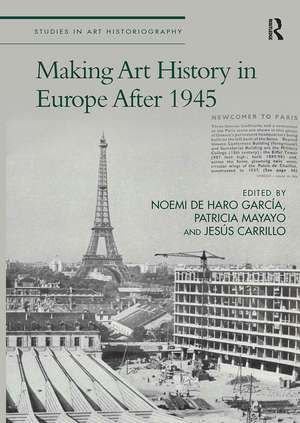Making Art History in Europe After 1945: Studies in Art Historiography
Editat de Noemi de Haro García, Patricia Mayayo, Jesús Carrilloen Limba Engleză Paperback – 29 aug 2022
Devoting special attention to European peripheries and to under-researched transnational cultural political initiatives related to the arts implemented after the end of the Second World War, the contributors explore the ways in which this relationship crystallised in specific moments, places, discourses and practices. They make the historic hegemonic centres of the discipline converse with Europe’s Southern and Eastern peripheries, from Portugal to Estonia to Greece.
By stressing the margins’ point of view this volume rethinks the ideological grounds on which art history and the European Union have been constructed as well as the role played by art and culture in the very concept of ‘Europe.’
| Toate formatele și edițiile | Preț | Express |
|---|---|---|
| Paperback (1) | 326.74 lei 3-5 săpt. | +23.54 lei 4-10 zile |
| Taylor & Francis – 29 aug 2022 | 326.74 lei 3-5 săpt. | +23.54 lei 4-10 zile |
| Hardback (1) | 764.20 lei 6-8 săpt. | |
| Taylor & Francis – 9 mar 2020 | 764.20 lei 6-8 săpt. |
Din seria Studies in Art Historiography
-
 Preț: 355.69 lei
Preț: 355.69 lei -
 Preț: 311.26 lei
Preț: 311.26 lei - 9%
 Preț: 935.87 lei
Preț: 935.87 lei -
 Preț: 312.75 lei
Preț: 312.75 lei -
 Preț: 328.18 lei
Preț: 328.18 lei - 16%
 Preț: 261.28 lei
Preț: 261.28 lei - 14%
 Preț: 328.19 lei
Preț: 328.19 lei - 17%
 Preț: 259.98 lei
Preț: 259.98 lei -
 Preț: 387.75 lei
Preț: 387.75 lei -
 Preț: 418.65 lei
Preț: 418.65 lei -
 Preț: 449.41 lei
Preț: 449.41 lei -
 Preț: 381.72 lei
Preț: 381.72 lei -
 Preț: 389.27 lei
Preț: 389.27 lei - 25%
 Preț: 769.66 lei
Preț: 769.66 lei -
 Preț: 390.80 lei
Preț: 390.80 lei - 17%
 Preț: 259.98 lei
Preț: 259.98 lei -
 Preț: 396.02 lei
Preț: 396.02 lei - 9%
 Preț: 1003.50 lei
Preț: 1003.50 lei -
 Preț: 449.41 lei
Preț: 449.41 lei - 9%
 Preț: 936.75 lei
Preț: 936.75 lei - 18%
 Preț: 299.52 lei
Preț: 299.52 lei - 18%
 Preț: 1048.88 lei
Preț: 1048.88 lei - 16%
 Preț: 325.34 lei
Preț: 325.34 lei - 21%
 Preț: 258.09 lei
Preț: 258.09 lei -
 Preț: 383.30 lei
Preț: 383.30 lei - 30%
 Preț: 799.70 lei
Preț: 799.70 lei - 21%
 Preț: 258.91 lei
Preț: 258.91 lei -
 Preț: 386.61 lei
Preț: 386.61 lei
Preț: 326.74 lei
Nou
Puncte Express: 490
Preț estimativ în valută:
62.54€ • 67.96$ • 52.57£
62.54€ • 67.96$ • 52.57£
Carte disponibilă
Livrare economică 01-15 aprilie
Livrare express 15-21 martie pentru 33.53 lei
Preluare comenzi: 021 569.72.76
Specificații
ISBN-13: 9781032400518
ISBN-10: 103240051X
Pagini: 292
Ilustrații: 44
Dimensiuni: 174 x 246 x 20 mm
Greutate: 0.48 kg
Ediția:1
Editura: Taylor & Francis
Colecția Routledge
Seria Studies in Art Historiography
Locul publicării:Oxford, United Kingdom
ISBN-10: 103240051X
Pagini: 292
Ilustrații: 44
Dimensiuni: 174 x 246 x 20 mm
Greutate: 0.48 kg
Ediția:1
Editura: Taylor & Francis
Colecția Routledge
Seria Studies in Art Historiography
Locul publicării:Oxford, United Kingdom
Public țintă
Postgraduate and UndergraduateCuprins
1. The (Re)Makings of Art History and Europe after 1945 [Noemi de Haro García, Patricia Mayayo and Jesús Carrillo] Section 1: Europe after the Rain 2. The Allied Cultural Policies in Germany after 1945: between “Re-education” and the Politization of the Arts [Morgane Walter] 3. UNESCO’s Color Reproductions Project: Bringing (French) Art to the World [Rachel Perry] 4. Curatorial Experiments at the National Gallery after the Second World War. Reframing History and the Pursuit of Aesthetic Experience [Ana Baeza Ruiz] 5. The Venice Biennale at Its Turning Points: 1948 and the Aftermath of 1968 [Stefano Collicelli and Vittoria Martini] Section 2: Re-reading Cold-War Narratives 6. The Museum of Contemporary Art in Belgrade and Post-Revolutionary Desire: Producing the Art History Narrative of Yugoslav Modern Art [Jasmina Cubrilo] 7. Artists in Service of the Masses: The Untold Story of the Yugoslav Socialist Realist Project [Ivana Hanacek] 8. Simultaneous Equations: Early Cold War Cultural Politics and the History of Art in Greece [Areti Adamopoulou] 9. Cold War Art Historiography: Some Observations on an Interdisciplinary Approach through the Social Sciences, [Nancy Jachec] 10. Something is Happening Here. Spaces and Figures of Change in Post-War Portugal [Luis Trindade] Section 3: A New Europe? 11. Art Policies, Identity and Ideology in Spain during the 1980s [Daniel A. Verdú Schumann] 12. Official Art Becoming Resistance. Adopting the Discourse of Dissent into Estonian Art History Writings [Kädi Talvoja]13. Gendering Art and Art History in Poland: A Story of Subversion [Pawel Leszkowicz] 14. Narrating Dissident Art in Spain: the Case of Desacuerdos. Sobre Arte, Políticas y Esfera Pública (2003-2005) [Alberto López Cuenca]
Notă biografică
Noemi de Haro García is Ramón y Cajal Research Fellow in the Art History Department of the Universidad Autónoma de Madrid.
Patricia Mayayo is Senior Lecturer in the Art History Department of the Universidad Autónoma de Madrid.
Jesus Carrillo is Senior Lecturer in the Art History Department of the Universidad Autónoma de Madrid.
Patricia Mayayo is Senior Lecturer in the Art History Department of the Universidad Autónoma de Madrid.
Jesus Carrillo is Senior Lecturer in the Art History Department of the Universidad Autónoma de Madrid.
Recenzii
"In sum, this book highlights an interesting omission in art historiography, and sets a new agenda in decentralising the approach of art historiography by shifting the focus from a regional to a geopolitical perspective."
--Journal of Art Historiography
--Journal of Art Historiography
Descriere
This book analyzes the relationship between art historical discourses, power, and the concept of Europe since 1945 from a critical, de-centered perspective.
